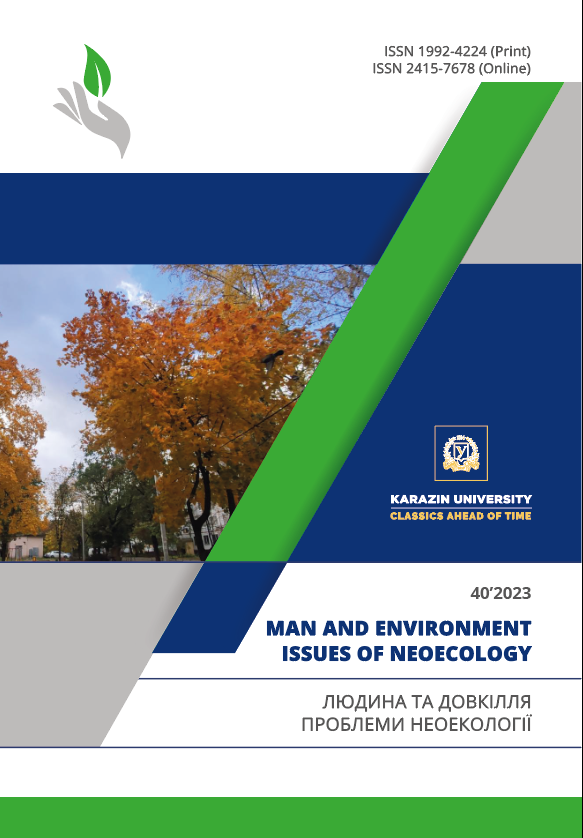Zoning of highways of the Cherkasy region according to the degree of formation of ecosystem relations
Abstract
The research is due to the great attention paid to the preservation and restoration of biodiversity in the countries of the European Union.
Purpose. Carrying out zoning of the Cherkasy region according to the degree of completeness of the formation of roadside landscapes ecosystemsю
Methods. From a methodological point of view, zoning is considered as one of the main methods of geographical analysis a nd synthesis. Zoning performs the function of a general geographic method of organizing spatial diversity in the geographic envelope and systematizing territorial formations at the regional level, which makes it an essential element of a systematic approach in geography.
Results. The monitoring parameters of the infrastructure components of the main highways of the Cherkassy region (Kyiv-Odesa and Vinnytsia-Uman) used by us can be used for zoning, provided they are combined into logically formed factor groups. In particular, we combined all the initial parameters into the following groups of factors: natural-geographic factor: geolocation (geographic coordinates), air temperature and humidity, natural radiation background; degree of anthropogenic impact: noise level, dustiness, some geochemical indicators, proximity (or remoteness) of the road surface from agricultural land; the degree of manifestation of ecosystem relations: the number of plant species and their recurrence, the presence of invasive species and those that are indicators of salinity and waterlogging, the presence of species included in the National Catalog of Biotopes of Ukraine. Based on the list of main groups of factors, the main indicator of zoning will be the degree of completeness of the formation of roadside ecosystems.
Conclutions. Taking into account the activation of ruderal flora at the exits from gas stations, or on remote sections of highways, it can be asserted that in these locations the Le Chatelier-Brown principle is fully in effect, according to which the biosphere compensates for the harmful effects from the outside with its diversity. The author sees prospects for further research in the expansion of the list of objects, in particular, it will be very interesting to investigate the formation of ecosystem relations on secondary communication routes.
Downloads
References
Sonko, S., Maksymenko, N., Vasylenko, O., Chornomorets, V., Koval, I. (2021). Biodiversity and landscape diversity as indicators of sustainable development. A. Generowicz, B. Burkinskyi and V. Koval (Eds.). International Conference on Sustainable, Circular Management and Environmental Engineering (ISCMEE 2021). Odesa, Ukraine, E3S Web of Conferences, 255 https://doi.org/10.1051/e3sconf/202125501046
Sonko, S.P. (2009). The process of formation of regions and the essence of the concept of "region". In Social development of rural regions. Qty. monograph. Uman Kind. "Sochynskyi".12-14.
Petlin, V. M. (2019). Harmony of organization of natural territorial systems: monograph. Lutsk: Ed. Center of Lesya Ukrainka East European National University,
Ogilko, S.P. (2023). The formation of roadside ecosystems is another evidence of the inviolabil-ity of the biosphere: the main conclusions of the highway monitoring study. The norwegian journal of development of the international science, (114), 3- 10. https://doi.org/10.5281/zenodo.8249380
Karasov, O.; Heremans, S.; Külvik, M.; Domnich, A.; & Chervanyov, I. (2020). On How Crowdsourced Data and Landscape Organisation Metrics Can Facilitate the Mapping of Cultural Ecosystem Services: An Estonian Case Study. Land, 9 (5),, 158. https://doi.org/10.3390/land9050158
Kuzemko, A.A., Didukha, J.P., Onishchenko, V.A., Schaeffer, Ya. (Eds.). (2018). National cata-log of biotopes of Ukraine. Kyiv: FOP Klymenko Yu.Ya.
Shablii, O., & Vlach, M. (2020). To the question of the constructiveness of social geography. Proceedings of the International scientific and practical online conference "Constructive geography and cartography: state, problems, prospects", Ukraine, Lviv, October 1‒3, 2020. 46-50.
Topchiev, O. G. Malchikova, D. S., Pylypenko, I. O., & Yavorska, V. V. (2020). Methodological principles of geography. Kherson: Publisher. "Helvetica" house.
-Orkusha, O.M. (2014). Zoning of road landscapes. Scientific notes of Mykhailo Kotsiubynskyi Vinnytsia State Pedagogical University. «Geography» series, (26), 67-71.
Copyright (c) 2023 Ogilko S. P.

This work is licensed under a Creative Commons Attribution 4.0 International License.
Authors reserve the right of attribution for the submitted manuscript, while transferring to the Journal the right to publish the article under the Creative Commons Attribution License 4.0 International (CC BY 4.0). This license allows free distribution of the published work under the condition of proper attribution of the original authors and the initial publication source (i.e. the Journal)
Authors have the right to enter into separate agreements for additional non-exclusive distribution of the work in the form it was published in the Journal (such as publishing the article on the institutional website or as a part of a monograph), provided the original publication in this Journal is properly referenced
The Journal allows and encourages online publication of the manuscripts (such as on personal web pages), even when such a manuscript is still under editorial consideration, since it allows for a productive scientific discussion and better citation dynamics (see The Effect of Open Access).





